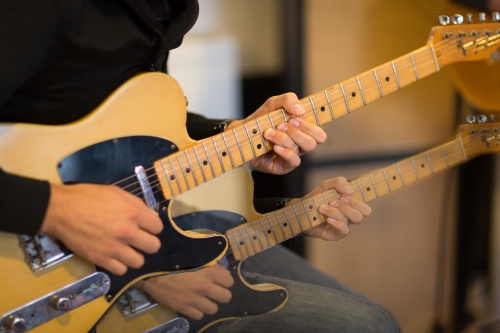Double tracking is a very common recording and production technique for almost any genre of music. When it comes to rhythm guitars, this technique is almost a standard method of recording, with single tracking used only for solos.
It’s also a technique that is often confusing for beginners. Double tracking simply means recording the same part twice and panning each to opposite sides.
The guitarist plays a section of the song perfectly, then repeats it as closely as possible on a second track. This creates a wide stereo spread based on the unique nuances in timing and dynamics of each performance.
It isn’t the same as recording in stereo, using two microphones, a chorus effect, or duplicating and delaying one side. Some of these techniques are ways of “faking” or producing “automatic” double tracking, but they’re simply no substitute for an expertly performed double track. There must be two separate performances for the effect to work.
How To Double Track Guitars
1) Record mono rhythm guitar, with either a microphone on a real amp or virtual amp. This track would be panned center.
2) When a good take is achieved, and any punch ins are finished, go through the recorded track and tighten up any timing issues.
Here’s how it sounds with the first guitar along with drums. The guitar is in the middle. LISTEN (Warning – heavy metal!)
3) After editing, pan this guitar (and any extra mics for this performance) to the left.
4) That was perfect, now play it again! Make a new track and pan it right.
5) Repeat steps 1 and 2 using the same guitar, pickup selection, amp, mic and any other variables unchanged. Making a change will increase the stereo width but will often result in an unbalanced tone.
Here’s the same part with the doubled guitars. LISTEN
This repeats for each section of the song and if there are multiple guitar parts written or two guitarists in the band, usually each will be double tracked.
If there are two guitarists in the band, there could be some confusion. Guitarist 1 plays all parts twice, Guitarist 2 plays all parts twice. In a simple song this would mean four tracks for the rhythm guitars. Often this gets up to 12 or 16 tracks pretty quickly. Guitar solos are usually right up the middle or “stereoized” with other techniques to make them pop out.
Be careful playing the doubled part; if it’s too far off from the original it will make a unwanted ping-pong effect, especially in headphones.
Quad tracking is exactly the same, but you record each part four times. Each take has to be perfectly in sync or it just sounds like a terrible mess.
Poor Alternatives
So why can’t we just duplicate and delay/shift the recording a little for the same effect? Well, simply because it sounds lousy.
This is what happens when you copy the original mono recording, delay the copy by 20 ms and pan each hard left and right. LISTEN
Similarly, why not use a stereo chorus? LISTEN
It still sounds really bad compared to double tracking. I’m not saying don’t ever use chorus, just don’t use it as an alternative to the big wide powerful double track sound.
This article is provided by Audio Geek Zine.




















